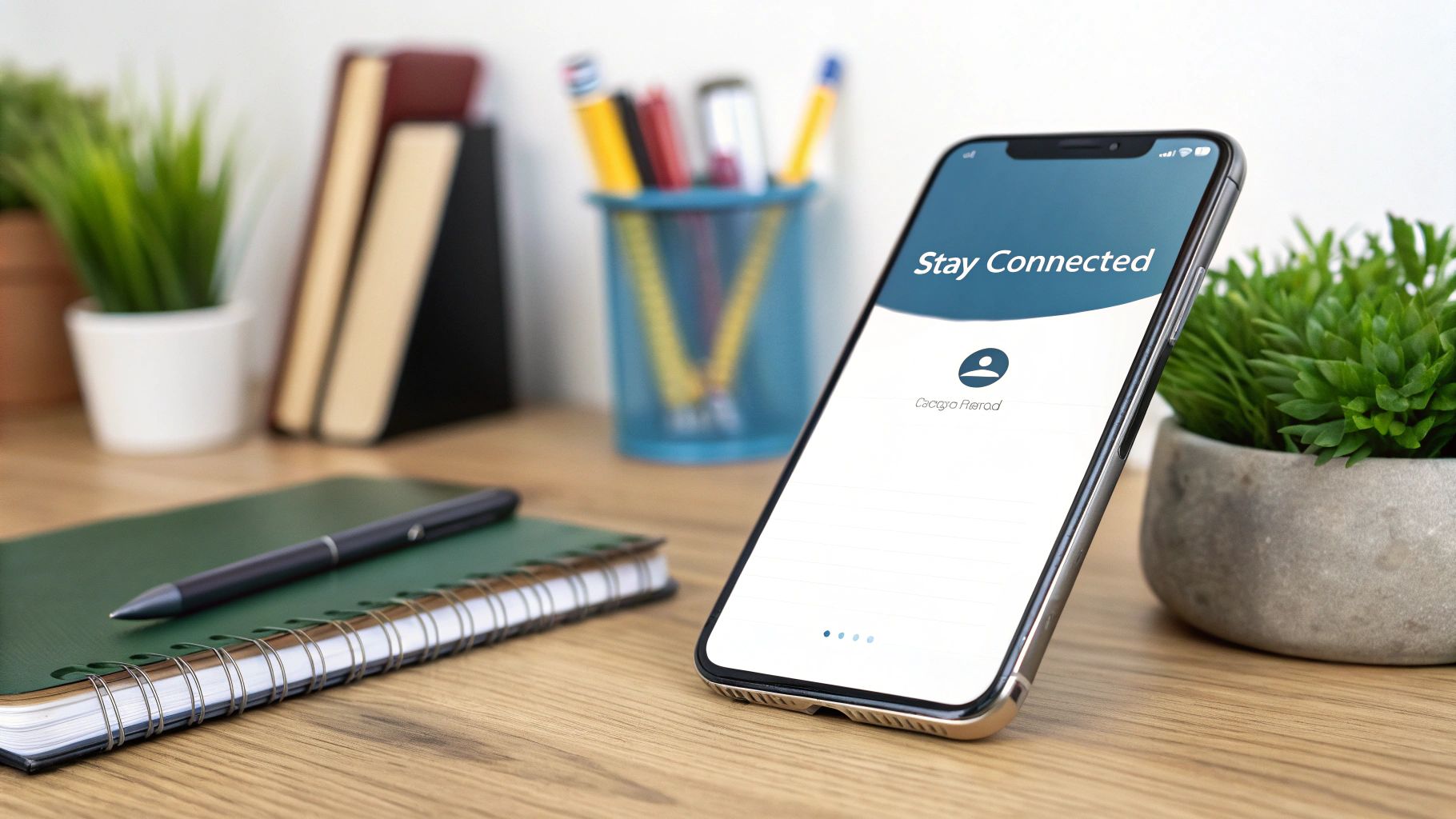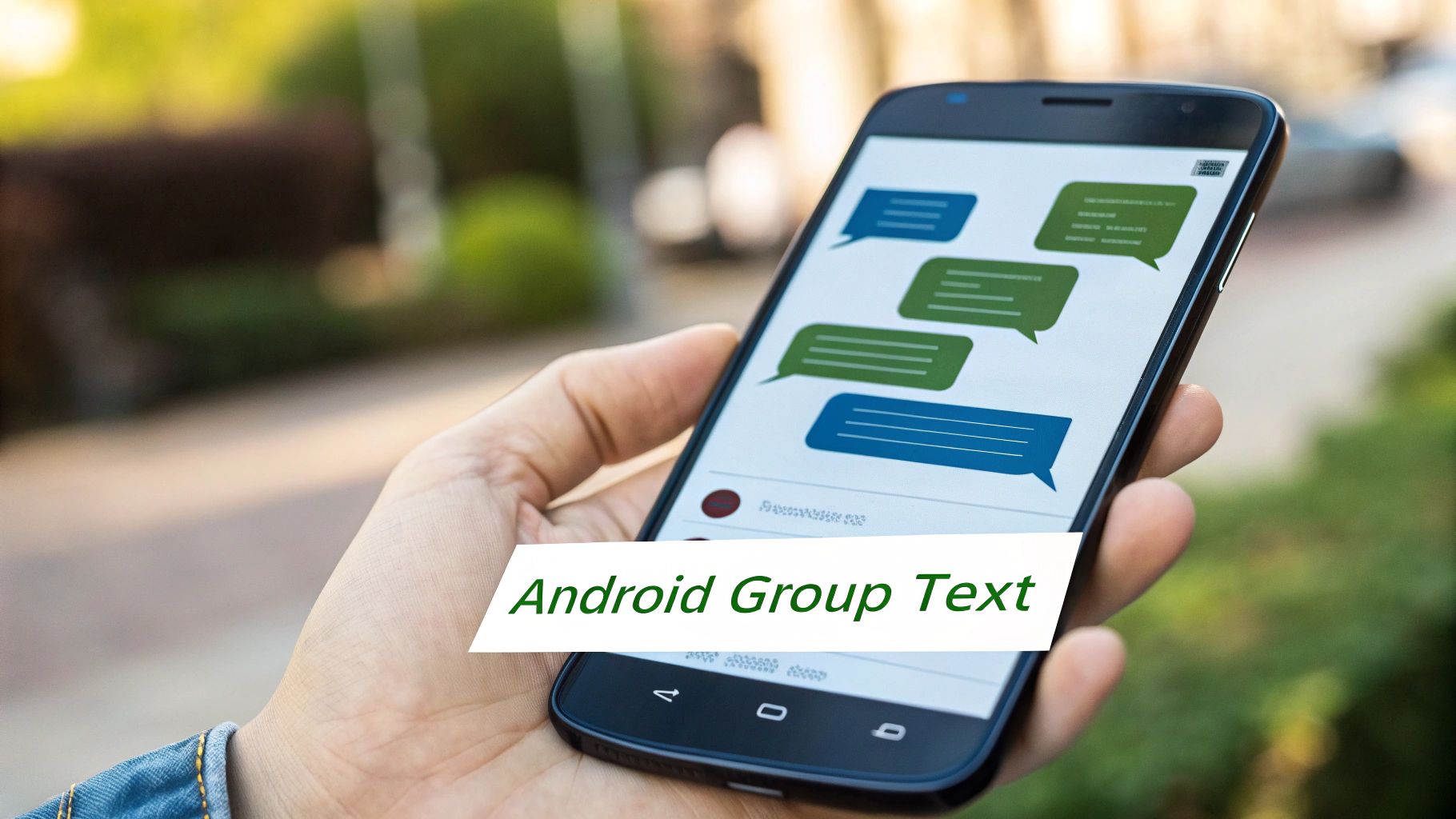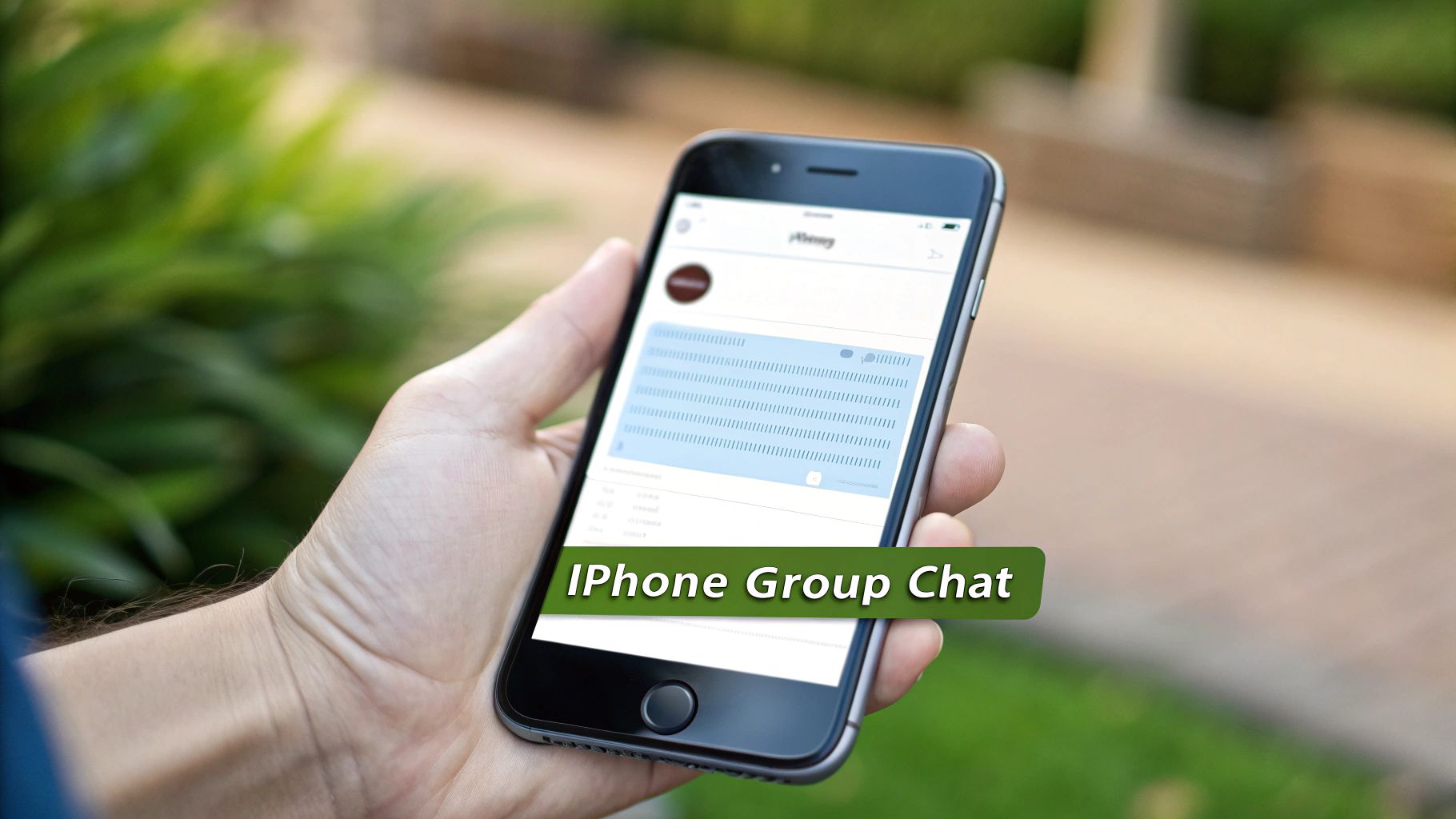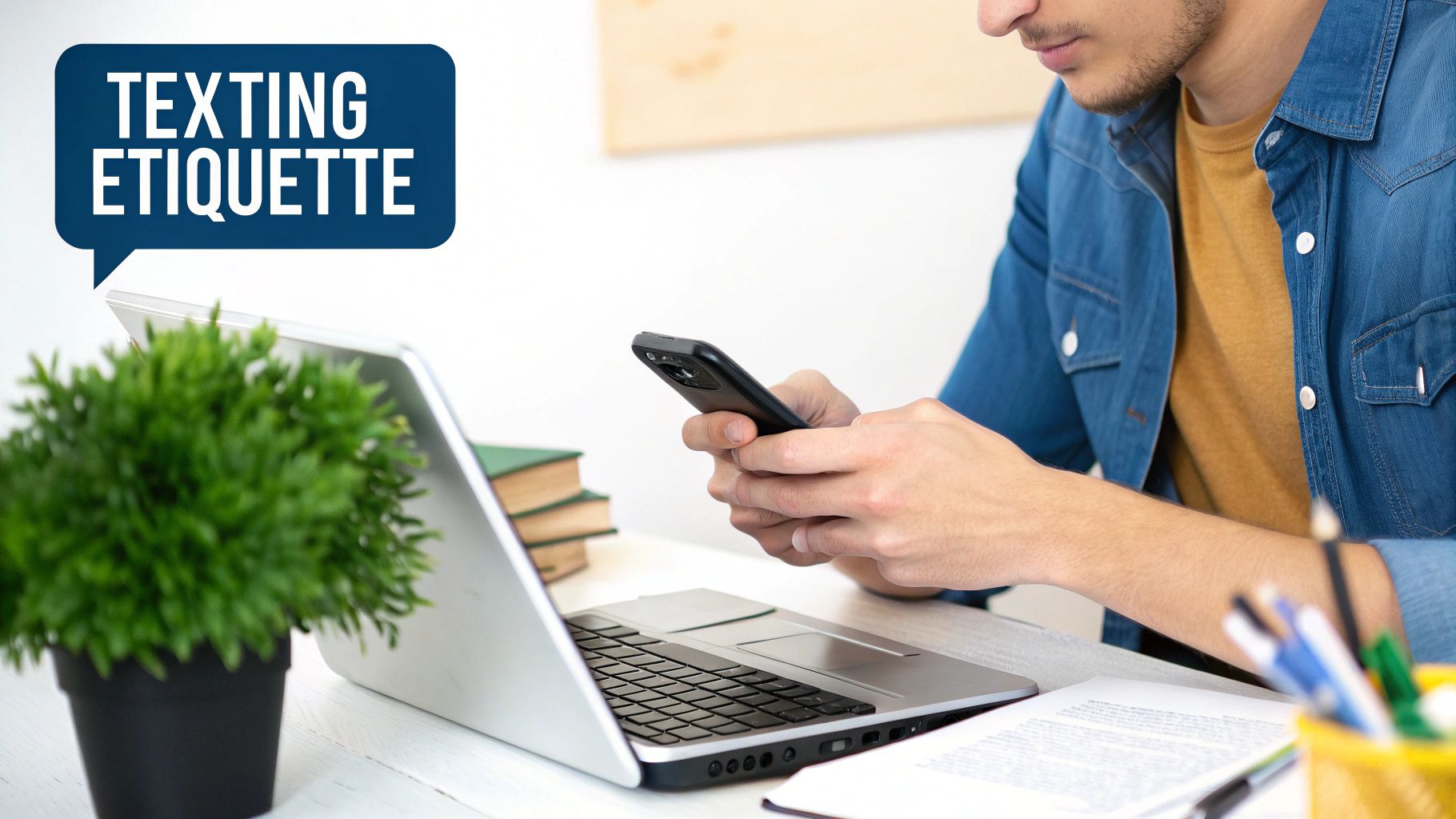To really make an impact, you need a way to send group texts that cuts through the noise and grabs immediate attention. This goes way beyond your phone's built-in messaging app. It's about using a dedicated platform to strategically manage your contacts, write messages that people actually want to read, and see what's working.
Why Group Texts Are a Game Changer for Engagement
Before we jump into the "how-to," let's talk about the "why." If you've ever felt like your emails are just disappearing into a packed inbox, you're not imagining things. The honest truth is that text messaging gives you a direct line to your audience that other channels just can't compete with. It’s immediate, personal, and incredibly effective.

The data here is pretty compelling. The SMS marketing space is on track to hit $12.6 billion by 2025, and it's all because of how well it performs. Text campaigns boast a jaw-dropping 98% open rate, with most messages being read within just a few minutes of being sent.
Let's put that into perspective with a quick comparison.
Group Text vs Email Engagement at a Glance
Ever wondered how your efforts stack up channel-to-channel? Here's a straightforward look at why so many are shifting focus to SMS.
The numbers don't lie. While email has its place, for quick action and guaranteed visibility, texting is in a league of its own.
The real magic is in the response. With an average response rate of 45%, text messaging isn't just about broadcasting—it's about starting a real conversation. That's what drives measurable action.
Real-World Strategic Advantages
Think about these scenarios where the speed of a group text makes all the difference:
- Retail Flash Sales: A local boutique texts a "2-hour flash sale" alert to its VIP list. The result? Immediate foot traffic and a spike in sales that an email, opened hours later, would have missed.
- Appointment Reminders: A dental clinic cuts down on no-shows by sending automated text reminders 24 hours before, and then a final nudge 2 hours before an appointment.
- Event Updates: A nonprofit instantly lets attendees know about a last-minute venue change for their fundraiser, making sure everyone gets the memo and shows up at the right place.
In every case, the immediacy and near-guaranteed visibility of a text message are what make it work. For businesses ready to build out a full strategy, exploring different bulk messaging solutions is the next logical step. Knowing how to send group texts the right way isn't just a "nice-to-have" skill anymore—it’s essential for modern communication.
Building a Compliant and High-Quality Contact List
To really succeed with group texts, you need a solid foundation—your contact list. This isn't just a numbers game. From my experience, a high-quality list built on trust and consent will always outperform a massive, disengaged one. Getting this right from the start saves you from compliance headaches and makes sure your messages are actually welcomed, not ignored.
The most common starting point is importing contacts from a CSV file. Think of it as your digital address book. Before you even think about uploading, make sure your file is clean and formatted correctly. The key here is consistency. Ensure columns like "First Name," "Last Name," and "Phone Number" are clearly labeled and only contain the right information. A little bit of housekeeping now prevents major upload errors down the line.
As you can see above, a well-organized platform like Textla makes adding and managing your contacts straightforward. Having a clear view of your audience from day one is the first real step toward powerful personalization and segmentation.
Gaining and Respecting Consent
If there’s one golden rule in text marketing, it’s this: gaining explicit consent. This is completely non-negotiable for TCPA compliance and for building a genuine relationship with your audience. You absolutely must have documented permission before sending anyone a promotional text.
Think of consent as a digital handshake. Your contact is giving you permission to enter their most personal space—their text message inbox. Respecting that trust is crucial for long-term engagement and brand reputation.
So, how do you get this permission?
- Website Forms: Add a checkbox on your signup or checkout forms that people must actively click to opt-in. Don't pre-check it!
- Keywords: Ask people to text a specific word (like "JOIN" or "DEALS") to your number to subscribe. This is a clear, trackable opt-in method.
- In-Person Signups: Use a tablet or a simple signup sheet at your physical store or at events.
A cornerstone of managing these permissions and personalizing your group texts is a robust CRM WhatsApp integration, which can help centralize your communication efforts.
Finally, always remember to include a clear way to opt-out, like "Reply STOP to end," in your messages. This isn't just about staying compliant; it shows you respect your contacts' choices. For a deeper look into setting up your campaigns, check out our guide on using an automated text message service.
Segment Your Audience to Send Messages That Actually Matter
Blasting the same generic message to your entire contact list is a bit like shouting into a void. Sure, it's easy, but most people will just ignore you. This is where the real magic of professional group texting comes in: segmentation. This isn't just about splitting your list into random groups; it's about creating focused, relevant conversations that get people to actually respond.

Instead of a one-size-fits-all text, you can craft messages based on what you know about your customers. The possibilities here are huge. A retail shop could create a "VIP Customers" segment for anyone who's spent over $500, then hit them with an exclusive early-access sale. A local nonprofit could target volunteers by their zip code for an urgent, location-specific need.
When you get this specific, your texts feel like a helpful tip, not spam.
How to Build Powerful Segments
The secret is using the data you already have to group your contacts in a way that makes sense. Here are a few of the most effective ways I've seen businesses segment their lists before sending a group text:
- By Purchase History: Group customers who bought a specific item. If you run a pet supply store, you could send a special offer on dog food exclusively to people who've bought it before. Simple, yet incredibly effective.
- By Location: Use geographic data to your advantage. This is perfect for announcing a new store opening or a local event to people who can actually show up.
- By Engagement Level: Why not reward your biggest fans? Create a segment of your most engaged subscribers—the ones who always click your links—and send them a special thank-you offer.
The goal is to send the right message to the right person at the right time. Segmentation stops you from annoying contacts with offers they couldn’t care less about, which is a surefire way to get them to hit "STOP."
This targeted approach is only going to get more important. With 5G networks expected to have 1.2 billion connections by 2025, text messaging will become even faster and more reliable, allowing for richer communication.
By dividing your audience, you can craft messages that speak directly to their interests. For a deeper dive into different strategies, check out our complete guide on audience segmentation examples.
Alright, you've got your contact segments sorted. Now for the fun part: writing the actual message and getting it in front of the right people at the right time.
This is where the magic really happens. A great group text should feel personal, deliver real value, and nudge your subscribers to take action. It's a bit of an art, but there's definitely a science to it.
First, let's talk copy. Keep it short and sweet. People glance at texts, they don't read essays. Get straight to the point. The easiest win? Use personalization. A simple "Hey, {FirstName}," instantly makes your text feel like it came from a human, not a faceless company.
Of course, a picture is worth a thousand words, right? This is where MMS (multimedia messaging) becomes your secret weapon. Dropping in a high-quality photo of a new product or a fun GIF celebrating a sale can make your message pop. Don't go overboard, but a single, well-chosen visual can make your campaign something people remember.
You can see below just how simple Textla makes it to write your message, pop in a personalization tag, and add an image for an MMS send.

Having everything you need in one clean interface means you can focus on crafting the perfect message without wrestling with clunky software.
Nail the Timing for Maximum Effect
Writing a killer text is only half the job. Sending it at the right moment is just as critical. A promo for a lunch special that lands at 8 PM is a total dud. An event reminder sent a week early is guaranteed to be forgotten.
Think of scheduling as the final piece of the puzzle. The best message sent at the wrong time is just noise. The same message, timed perfectly, drives results.
So, when should you send? Based on my experience, here are a few solid strategies:
- For Retail Promotions: Try for late morning (around 10-11 AM) or that mid-afternoon slump (2-4 PM) on weekdays. That’s often when people are making after-work shopping plans.
- For Event Reminders: I always recommend a two-tap approach. Send the first reminder 24 hours before the event, then a final one 2-3 hours before it kicks off.
- For General News: Mid-week, during standard business hours, is usually a safe bet for getting good engagement on general announcements.
From that first "Merry Christmas" text back in 1992 to the 18.8 million messages zipping around every minute today, the power of texting has only exploded. Nailing your timing is how you cut through that noise. If you're a data geek like me, you can dig into more eye-opening SMS marketing stats on Mozeo.com to get the full scoop.
Analyzing Your Performance to Improve Next Time
Once your group text is out the door, the real work begins. This is where you move from hoping your campaign works to knowing what works. Digging into your campaign analytics is how you get better, turning each send into a lesson for the next one.

There are three metrics I always watch like a hawk: delivery rate, click-through rate (CTR), and unsubscribe rate. A high delivery rate tells you your contact list is in good shape, but the other two tell the real story of how your audience felt about your message.
Reading Between the Numbers
Don't just glance at the percentages; ask yourself why they are what they are. A low CTR, for instance, could mean your offer wasn’t juicy enough or your call-to-action was a bit fuzzy. It’s a signal to experiment with your wording or even the landing page you’re sending people to.
A sudden spike in unsubscribes right after a message is one of the most honest pieces of feedback you can get. Your audience is telling you, point-blank, that the content missed the mark or the timing was off. Don't get discouraged—use that insight to sharpen your segments and rethink your messaging.
On the flip side, link clicks show you exactly what piques your audience's interest. If a link to your new spring collection gets mobbed with clicks, you've just found a golden ticket for what to promote next.
- High CTR: Great job! Your message and offer are hitting the sweet spot. See if you can replicate that success in future texts.
- Low CTR: Your call-to-action probably needs a tune-up. Test different offers or more compelling language.
- High Unsubscribes: This is a red flag. You might have messaged the wrong group of people or are sending texts a little too often.
This cycle of sending, analyzing, and refining is the core of effective outreach. For a refresher on the basics, you can get more details on how to send a mass text in our full guide. When you analyze your results, you stop guessing and start making strategic moves that get you where you want to go.
Common Questions About Sending Group Texts
Jumping into a new platform for sending group texts always brings up a few questions. Getting these sorted out from the get-go saves you a ton of time and helps you build a communication strategy that actually works. Let’s tackle some of the most common ones I hear.
One of the first points of confusion is the difference between a "group text" and a "mass text." Think about the group chats you have on your phone for family or friends—everyone sees every reply in one long, chaotic thread. That’s a standard group text.
A mass text, which you send through a service like Textla, is different. It sends an individual message to each person on your list. When someone replies, their message comes privately to you, not the entire group. This is absolutely essential for professional business communication.
Keeping Your Texts Welcomed, Not Blocked
The next big question is always about spam. How do you make sure your messages land as a welcome update and not an annoying interruption? It all comes down to trust and delivering real value.
The non-negotiable first step is this: only text people who have explicitly given you permission. This is called an opt-in. Never, ever buy a list or add numbers without their direct consent.
Beyond that, here are a few best practices I always recommend:
- Make it personal. A simple touch like using a merge tag to add the contact's first name goes a long way.
- Offer real value. Every single text needs a clear purpose. Is it an exclusive discount, a helpful tip, or a critical update?
- Provide an easy out. Always include a clear and simple way to unsubscribe, like "Reply STOP to cancel."
Remember, every message you send is an opportunity to either strengthen your relationship with a customer or damage it. A welcomed text provides value and respects boundaries; spam ignores both.
Maximizing Your Campaign's Impact
So, when is the best time to send a group text? Honestly, the answer is: it depends entirely on your audience and what you're trying to achieve.
For retail promotions, sending during business hours between 10 AM and 6 PM usually hits the sweet spot. If you’re sending event reminders, a proven strategy is to send one text the day before and a follow-up a few hours before it starts. The real key is to test different times, watch your analytics, and see what resonates with your specific audience.
And finally, "Can I include links?" Absolutely—you definitely should! Links are your gateway to driving action, whether you want someone to visit your website, check out a new product, or RSVP for an event. Using a link shortener is a smart move. It not only saves precious character space but also lets you track click-through rates, which is a vital metric for knowing if your campaign is truly a success.
Ready to send group texts that your customers will actually welcome? Textla provides all the tools you need—from easy contact segmentation to powerful analytics—in one straightforward platform. Start your free trial today and see the difference it makes.

